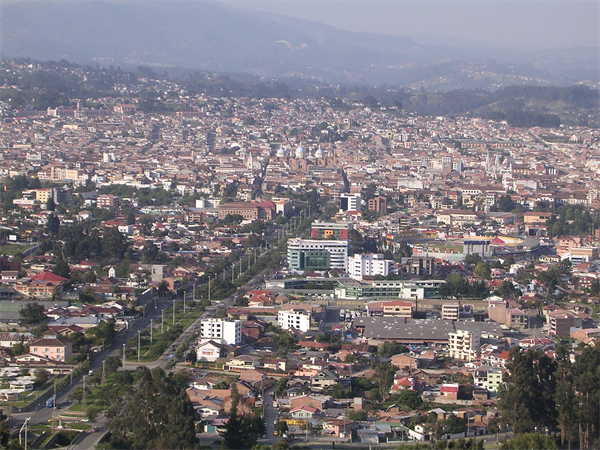- CURRENT LOCATION: HOME
- >> About Shaanxi
- >> Global Associations
- >> Sister Cities
- >>
- Xi'an
Cuenca (Ecuador)
2017-04-17 11:22:26 , Source : The Government Website of Shaanxi Province
The city of Cuenca — in full, Santa Ana de los cuatro ríos de Cuenca — is the capital of the Azuay Province. It is widely regarded as the most European city in the country of Ecuador due to its highly 16th and 17th century era Spanish colonial architecture resembling to cities and architecture throughout Spain. The city of Cuenca is located in the highlands of Ecuador at about 2,500 metres (8,200 feet) above sea level, with an urban population of approximately 400,000 rising to 700,000 inhabitants in the larger metro area. The centre of the city is listed as a UNESCO World Heritage Trust site due to its many historical buildings. Cuenca is well known for its stunning architecture, tourist attractions, hotels and night activities.
Population
As per the last INEC estimate for 2015, the population of the Cuenca canton was 580,000 inhabitants, of which 400,000 constitute the urban population (i.e., the population of the city proper). The economic development is based on industry and agricultural development.
Cuenca Metropolitan Area includes the cities of Azogues, Biblian and Deleg in the cañar province and the cities of Paute and Gualaceo in the Azuay province with a population of 730,000 inhabitants; however, Cuenca's influence in the cultural, economic and educational areas extends to all the remaining cities 50 miles (80 kilometres) around.
Economy
Cuenca is a city known for its textile making, along with furniture and other crafts like hats and shoes. They also export many flowers to places such as the United States and countries in Europe. The hats that they are well known for making are straw hats. The tourism industry is big as well in addition with the main university there, “La Universidad de Cuenca”. Cuenca has many cathedrals there that are a part of the sightseeing as well as other national parks. For the future, Ecuador has been working on electrolytic hydrogen for use of better resources that are environmental friendly. With Cuenca located in the sierras of mountains and much forest area nearby, mining and logging are industries there. Some of the common mined resources are kaolin, plaster, limestone, sand, specialized rocks, and carbon. Also, Cuenca is known for making tires for cars. They get a big supply of rubber from the forests. As far as farming, it has shrunken in the economy, but is still important part of the city. Beekeeping is actually a big part of it as far as the usual of livestock and growing crops. Some of the typical crops grown are wheat, barley, rye, oats and corn.
Geography and location Economy
Cuenca, capital of the province of Azuay, is located in the sierra of the Andes in the Austro or southern region of Ecuador. It is approximately nine hours south of Quito and four hours east of Guayaquil. The city ranges from 2,350 to 2,550 metres (7,710 to 8,370 feet) above sea level.
The dominant features of the city's geography are also the source of its name in Spanish: the four rivers of Cuenca (meaning a basin made by a confluence of rivers). These rivers are the Tomebamba (named after the Inca culture), Yanuncay, Tarqui and Machangara, in order of importance. The first three of these rivers originate in the Páramo of Parque Nacional Cajas to the west of the city. These four rivers are part of the Amazon river watershed. Cuenca is surrounded by mountains on all sides, with passes to the west, south and east.
Climate
Cuenca features a subtropical highland climate (Cfb) under the Köppen climate classification. Like the rest of the Ecuadorian Andes, Cuenca enjoys a mild climate year-round. Days are generally warm and nights are cool enough that sweaters or jackets are usually desired. The average daily temperature is 14.7 °C (58.5 °F). There are two seasons: rainy and dry. The dry season, with some variation, falls between June and December. The rainy season, which is characterized by bright sunny mornings and afternoon showers, falls between January and May. The heaviest rains come in the invierno (wet season) of March, April and May.
Main sights
Most tourists visit the historic area, which is a UNESCO World Heritage Site, between the river Tomebamba and the street Gran Colombia to the north, General Torres to the west, and Hermano Miguel to the east. This area's compactness, grid-like layout, and numerous readily identifiable monuments make it easy to navigate. Outside this area the city can be confusing, as there are dozens of narrow colonial streets with similar buildings.
Major fiestas of Cuenca come at the time of the "Mass of Children" that is carried out the day of the Arrival of Kings (January 6 - Epiphany Day), or in the commemoration of the independence of the city (November 3), during which processions, cultural acts and dances are organized. The nearby Cañar plantation (in the county of the same name) features the biggest Inca ruins in Ecuador.
Festivities
One of the festivities celebrated in Cuenca and in other parts of Ecuador is "El Carnaval" This is celebrated three days prior to Ash Wednesday. Families get together to celebrate what started as a "pagan ritual". Now it is celebrated by wetting friends and random people with water balloons and spraying "Carioca" a non staining foam.

Government Organizations



Other Links

Copyright@www.shaanxi.gov.cn All Rights Reserved
Registration Number:陕ICP备10004160号
